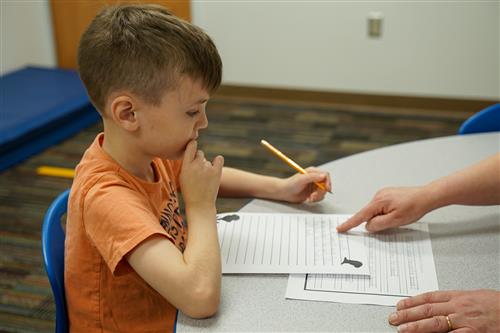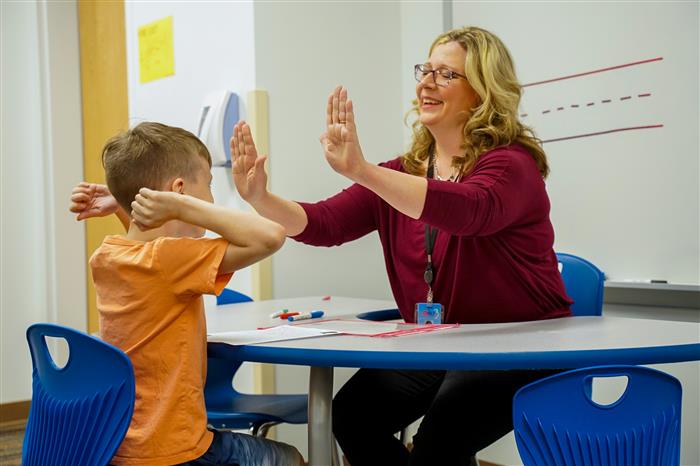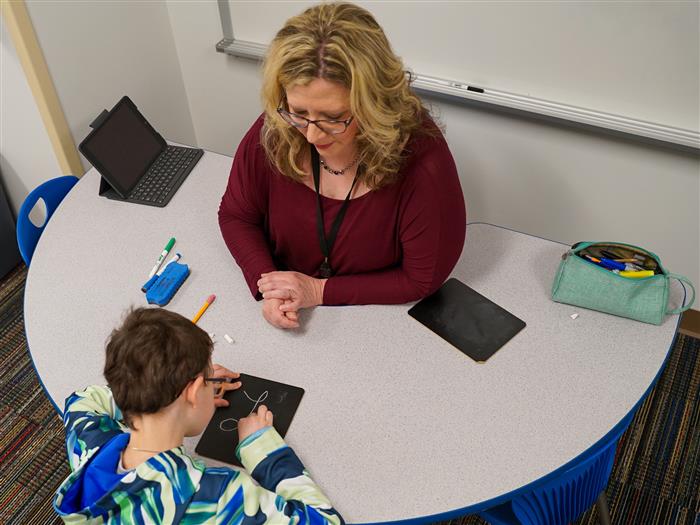Special Education Services
Page Navigation
- Special Education Services
- Special Education Schools
- Special Education Support Services
- Preschool Early Intervention
- Pupil Services
- Special Education Liaisons' Meetings
- Special Education and Pupil Services Calendar
- Specialized Transition Services
- Spotlight on Special Education Blog
- Greater Than the Sum of Our Parts
- Local Task Force Calendar
The Right to Write: AIU Spotlight on Occupational Therapy Handwriting Supports
Posted by AIU on 3/14/2023 12:30:00 PM
Evidence-based research shows that practicing handwriting using structured therapeutic instruction is the most effective method of improving handwriting. Therapists work with students one-on-one to build handwriting skills and then provide strategies for the teacher to support the student carrying over those skills into the classroom.
The written word has multiple components that students must learn to effectively participate in the classroom.
 Components for legible handwriting include letter formation and letter sizing, line awareness, spacing and accurate copying skills. AIU Occupational Therapists (OTs) evaluate these components to determine a student's areas of need to support them to participate in their educational program.
Components for legible handwriting include letter formation and letter sizing, line awareness, spacing and accurate copying skills. AIU Occupational Therapists (OTs) evaluate these components to determine a student's areas of need to support them to participate in their educational program.
Just as the English language has its phonetic complexities, the written word has the added dimension of physical outputs in the form of letter formation, keeping an orderly string of text and spacing, among other components. Some of the strategies used can be pencil grips to support grasp, highlighted lined paper and supports for spacing between words.
Then there’s speed.
“Some children try to write quickly and they need to learn to slow down and pace themselves,” says Mary Grassi, Supervisor of Occupational and Physical Therapy at the AIU. “We're not looking for perfection with [a student’s] letter formation or writing their letters just like in a book,” she added. “We want them to be able to write so that it is readable.”

Occupational therapists with the AIU use programs with proven effectiveness, including Handwriting Without Tears® and the Size Matters® handwriting program, among others. These programs often focus on the sizing of letters, the relative height of “tall” letters (such as h, d, and k) and differences between uppercase and lowercase letters, and much more.
In some cases, students may be unable to reach a point of legibility. The AIU’s OTs understand and meet every student where they are to provide the best adapted support. They include low-tech and high-tech adaptations such as adapted paper, use of keyboards via iPads or Chromebooks and supportive software to produce written communication.
“The main purpose is for them to participate successfully in their education,” Grassi said.
Recent
- April Spotlight: Aquatics Instruction and Therapy Supports at Pathfinder School
- Photo Gallery: Mess Fest brings science and creativity together at Mon Valley
- Photo Gallery: Duquesne Band Performs at Pathfinder School!
- Photo Gallery: Sensory Glow Run Shines at Pathfinder!
- March Madness at Sunrise Vs. Point Park Women's Basketball!
By Month
- April 2024
- March 2024
- February 2024
- January 2024
- December 2023
- November 2023
- October 2023
- September 2023
- June 2023
- May 2023
- April 2023
- March 2023
- February 2023
- January 2023
- December 2022
- November 2022
- October 2022
- September 2022
- August 2022
- July 2022
- June 2022
- May 2022
- April 2022
- March 2022
- February 2022
- January 2022
- December 2021
- September 2021
- August 2021
- June 2021
- May 2021
- April 2021
- March 2021
- February 2021
- December 2020
- June 2020
- May 2020
- April 2020
- March 2020
- February 2020
- January 2020
- December 2019
- November 2019
- October 2019
- September 2019
- August 2019
- June 2019
- May 2019
- April 2019
- March 2019
- February 2019
- January 2019
- December 2018
- November 2018
- October 2018
- September 2018


